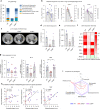STAT2 signaling restricts viral dissemination but drives severe pneumonia in SARS-CoV-2 infected hamsters
- PMID: 33203860
- PMCID: PMC7672082
- DOI: 10.1038/s41467-020-19684-y
STAT2 signaling restricts viral dissemination but drives severe pneumonia in SARS-CoV-2 infected hamsters
Abstract
Emergence of SARS-CoV-2 causing COVID-19 has resulted in hundreds of thousands of deaths. In search for key targets of effective therapeutics, robust animal models mimicking COVID-19 in humans are urgently needed. Here, we show that Syrian hamsters, in contrast to mice, are highly permissive to SARS-CoV-2 and develop bronchopneumonia and strong inflammatory responses in the lungs with neutrophil infiltration and edema, further confirmed as consolidations visualized by micro-CT alike in clinical practice. Moreover, we identify an exuberant innate immune response as key player in pathogenesis, in which STAT2 signaling plays a dual role, driving severe lung injury on the one hand, yet restricting systemic virus dissemination on the other. Our results reveal the importance of STAT2-dependent interferon responses in the pathogenesis and virus control during SARS-CoV-2 infection and may help rationalizing new strategies for the treatment of COVID-19 patients.
Conflict of interest statement
D.D.V., B.S., and X.S. are named as inventors on US patent application no. 62/988,610, entitled “Coronavirus Binders.” D.D.V., B.S., X.S., and N.C. are named as inventors on US patent application no. 62/991,408, entitled “SARS-CoV-2 Virus Binders.”
Figures



References
Publication types
MeSH terms
Substances
Grants and funding
LinkOut - more resources
Full Text Sources
Other Literature Sources
Molecular Biology Databases
Miscellaneous

